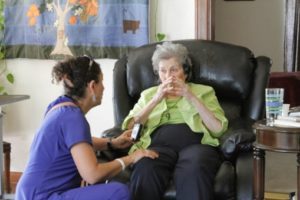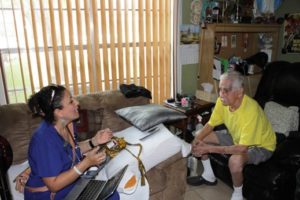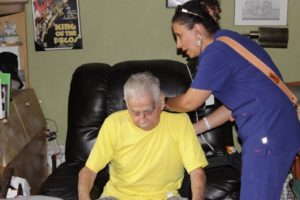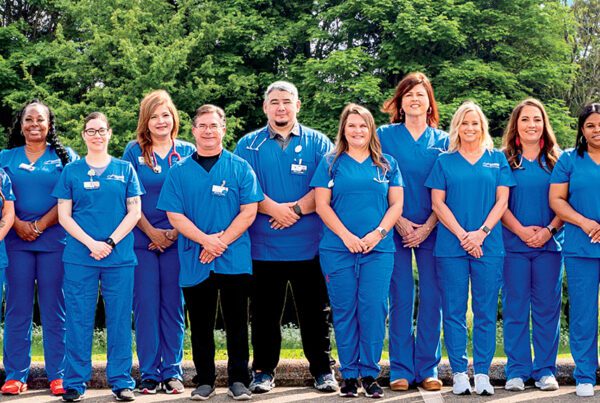When Dr. George Rapier founded WellMed Medical Management 25 years ago as a senior healthcare provider, one of his founding principles was to bring back the spirit of the black bag-toting physician who knew his patients and their family members by name.
He wanted doctors who understood the day-to-day needs of the people for whom they cared. They should be someone more at home in the horse-and-buggy days, when doctors made house calls as part of their routine.
Today, Dr. Rapier’s vision for WellMed “to change the face of healthcare delivery for seniors” is coming ever closer to reality with the expansion of an important specialty program for WellMed patients—The Bridges to Complex Care program.
“We’re essentially bringing back the ‘black bag’ model of care, where we provide comprehensive resources to treat the whole person.” -Dr. Elizabeth Glazier
It’s literally a house call program for patients with chronic, life-limiting disease states such as heart disease, cancer, diabetes or COPD. The program, which started in August 2013 in San Antonio, has expanded into Austin, Corpus Christi and El Paso, and it will soon be in the Rio Grande Valley. It’s provided at no additional costs to patients with Medicare Advantage Plan insurance coverage.
“The WellMed palliative care approach is meeting the patient, wherever they are in their diagnosis,” explains WellMed Associate Medical Director Dr. Elizabeth Glazier, a geriatrician who designed the program. “We’re essentially bringing back the ‘black bag’ model of care, where we provide comprehensive resources to treat the whole person.”
Called “Bridges,” the program provides care for some of WellMed’s sicker patients — patients whose needs were beyond what the group’s care management and clinic-based resources could provide, but for whom hospice services would not be appropriate, explained Dr. Richard Whittaker, Chief Medical Officer for WellMed Medical Group.
“The Bridges program is providing tailored care for patients,” Dr. Whittaker said. “We’re realizing better utilization of the medical group’s staff and significant cost savings.”

The program uses palliative care–trained physicians, non-physician practitioners and nurses who see the patients in their homes or in a clinic setting. Each patient receives advanced care planning. Care is coordinated between care management and the primary care physician. WellMed social workers may also be assigned to help with non-medical needs, such as coordinating food delivery from Meals on Wheels or helping indigent patients access government services to help offset utility bills. In many cases,hospice partners become involved as well.
The Bridges program starts with a visit to the patient’s home, or wherever the patient is most comfortable, so the Bridges team can have an initial discussion, collect some medical information, and even meet with the patient’s support network. Then members of the team — which can consist of not only physicians and nurse practitioners but also social workers, dieticians and other health professionals — coordinate appointments with the patient, adjusting depending on the patient’s need.
For patients and their families, Dr. Whittaker says, the benefits are improved care in their homes with fewer emergency room visits, hospitalizations and lower out-of-pocket costs. In 2014, the program helped reduce hospital admissions and ER visits for patients enrolled in the Bridges program by nearly half, from 710 admits per thousands to 376; from 1497 ER visits per thousand to 872.
Patients in the Bridges program can enjoy many of the additional services typical in hospice care for significantly longer periods of time than hospice is able to provide.
The program is also a win for patients’ primary care physicians, whether they are staff at any of the 100-plus WellMed clinics in Texas and Florida, where the Bridges program will also expand to in 2016, or the 6,000 independent physicians who contract with WellMed to support care of their Medicare-eligible patients. The Bridges team helps primary care physicians focus more on patients able to visit them in the medical facilities.
“Providers benefit from improved care for their patients and improved efficiency through the support they get from the palliative care team managing this population of patients for them since many of these patients require a significant amount of their time,” Dr. Whittaker noted.
Bridges is an adaptation of a program that Dr. Glazier started in Washington D.C. working with more than 250 poor, homebound elderly residents. She was named the 2006 “House Calls Doctor of the Year” by the American Academy of Home Care Physicians for those efforts.
 Dr. Glazier said she receives great satisfaction providing in-home care to her WellMed patients and their families. “I treat patients and their families on many levels,” she said. One of her concerns is the “high-utilization” patient who visits the emergency room for minor problems. Seeing those patients in the home produces amazing results, she said, such as fewer hospital visits and higher quality care.
Dr. Glazier said she receives great satisfaction providing in-home care to her WellMed patients and their families. “I treat patients and their families on many levels,” she said. One of her concerns is the “high-utilization” patient who visits the emergency room for minor problems. Seeing those patients in the home produces amazing results, she said, such as fewer hospital visits and higher quality care.
Yet it’s important to note this service is not the same as hospice. Palliative care targets patient comfort by treating the overall pain which may be related to a physical ailment, spiritual unrest or emotional imbalance. Palliative care specialists work hand-in-hand with other medical professionals to improve a person’s quality of life.
“One of the greatest challenges in acceptance is how often patients equate palliative care with hospice care,” said Dr. Glazier, explaining that, “Individuals believe they’re ‘not hospice-ready yet,’ which prevents them from benefiting from modern palliative and supportive care. This may include care coordination, pain management, and symptom management of comorbid conditions, such as depression. These help patients receive the care they want and eliminate unnecessary or unwanted hospital stays and emergency room visits.”
The groundbreaking nature of the program has attracted high-quality physicians to join in expanding Bridges, such as Dr. S. Liliana Oakes, named the AMDA 2014 Medical Director of the Year. The Colombian-born physician sees patients at their homes in San Antonio.
 In her living room on the southeast side of San Antonio, sitting in a chair that has the look that it’s her chair and hers alone, 93-year-old Willie Gates has on a matching lime green blouse and shirt with black pants, and just a touch of makeup. Dr. Oakes takes a seat next to her, in another sizeable chair, with a laptop plugged in. She makes sure to talk loudly and a little slower than usual to Willie, not only because she doesn’t hear as well as she used to, but also because Dr. Oakes understands her accent is a little hard to understand.
In her living room on the southeast side of San Antonio, sitting in a chair that has the look that it’s her chair and hers alone, 93-year-old Willie Gates has on a matching lime green blouse and shirt with black pants, and just a touch of makeup. Dr. Oakes takes a seat next to her, in another sizeable chair, with a laptop plugged in. She makes sure to talk loudly and a little slower than usual to Willie, not only because she doesn’t hear as well as she used to, but also because Dr. Oakes understands her accent is a little hard to understand.
Willie’s son, Burnell Gates, sits nearby with his arm and phone on the dinner table. He has a power of attorney and has to grant permission for the visit. Standing in the space between the living room and kitchen is Trina, one of the two caregivers for Willie Gates.
With a laptop displaying Willie’s information, Dr. Oakes goes over some issues of concern. She speaks clearly to her patient, her patient’s son, and the caregivers at the same time to make sure everyone understands the questions she’s asking and why she’s asking them.
Dr. Oakes begins a physical check on Willie. She checks her heart rate with a fingertip monitor as well as her blood pressure, both sitting and standing since blood pressure can change while standing up. While she has her patient standing, Dr. Oakes takes out a bathroom scale from her larger bag and asks Willie to stand on it. While helping her stand, Dr. Oakes remarks that she’s at a healthy weight for her age.
With the physical check out of the way, Dr. Oakes begins digging into her patient’s pill bag. Bottles small and big are contained in a large, sealable plastic bag. The prescriptions range from an anti-psychotic to a pill to push out fluid from the body.
The anti-psychotic is the big concern for Dr. Oakes. Even though she’s diagnosed with dementia, Willie doesn’t have hallucinations common to those with the same condition, so for Dr. Oakes, a strong anti-psychotic is not needed. She suggests to her caregiver and son that they should reduce her pill intake from twice a day to once a day. For Dr. Oakes, it’s important to reduce a patient’s medications if they’re no longer needed or a natural alternative is available.
Rather than taking a diuretic pill, she suggests cranberry tablets. Instead of a pill to lower cholesterol, Dr. Oakes says Willie should be taking two fish oil pills daily. When Willie raises her voice on why her doctor is not talking directly to her, Dr. Oakes explains that she wants to reduce the amount of pills she takes and asks if Willie would like that. “Absolutely,” she said.
 To finish her visit, Dr. Oakes suggests to the caregiver and Willie’s son to try to get her to be more active. Working on a puzzle or spending a Sunday at church can help physically, emotionally and spiritually, she shares.
To finish her visit, Dr. Oakes suggests to the caregiver and Willie’s son to try to get her to be more active. Working on a puzzle or spending a Sunday at church can help physically, emotionally and spiritually, she shares.
It’s then that Dr. Oakes explains how she likes to end a visit with a prayer. In a circle holding hands, Dr. Oakes prays with Ms. Gates, her son and caregiver. After the prayer, Willie says, “That’s the first time any doctor has prayed with me.”
The visit has clearly made an impression on the family. “Can you come back next week?” Burnell Gates asks as Dr. Oakes packs up her things and starts to wheel her bag to the door. “Come back soon.”
“It’s just the purest form of doctoring, to meet people where they are, to journey with them through their illness.” -Dr. Leigh Fredholm
This is the kind of experience that Dr. Rapier envisioned for patients in need of access to quality healthcare. In Austin, Dr. Leigh Fredholm is fairly new to the Bridges program, but not to the concept of taking care of patients in need.
“When I was in school from 1986 to 1992, it was some of the darker days of the AIDS epidemic. A lot of the patients we took care of were dying, and there was not a thing we could do about it. So we had to learn how to be in that space with patients, how to care for those who were dying. So I got comfortable there and found that I loved taking care of hospice patients when I was a resident,” recounted Dr. Fredholm.
“It’s just the purest form of doctoring, to meet people where they are, to journey with them through their illness.”
Dr. Fredholm, who is board-certified in family medicine, hospice and palliative medicine, grew up in San Antonio and earned her medical degree from the University of Missouri in Kansas City. She began her medical career as a small-town family practitioner in Taylor, Texas. For 15 years and up until just a few months ago, she was Medical Director for Seton Palliative Care in Austin.
Seventy-three-year-old Dorothy Boyd has been a patient of Dr. Fredholm’s for 25 years, long before she joined WellMed, but she never got home visits from the physician until now.
“Helping patients with chronic disease at this critical time in life…it’s very rewarding.” -Dr. Ronald Stephens
Dorothy, who is being treated for COPD and diabetes among other chronic illnesses, says she enjoys the personal attention from her longtime doctor, someone she considers a friend. “She can come here any time she wants and she knows it,” Boyd said with a grin.
In Corpus Christi, hometown hero Dr. Ronald Stephens just started bringing WellMed’s house call program to the Coastal Bend this summer. A native of the nearby suburb of Calallen, Dr. Stephens was formerly Director of Inpatient Palliative Care for St. Michael’s Hospital in Texarkana. He leads a team including nurse practitioner Amy Turner, two nurses and a medical assistant.
“I wanted to do this because it brought me back home, and because I’m very impressed with what WellMed is doing to improve patient care,” Dr. Stephens said. “In my mind, it’s more real medicine than what we do in the office. Helping patients with chronic disease at this critical time in life…it’s very rewarding.”
“It’s how we would want all of our loved ones to be treated.” – Dr. Elizabeth Glazier
The Bridges program has received strong adoption from patients and providers, in part because it encourages patients to join at the onset of their diagnosis and embraces the patient’s ability to continue to pursue concurrent, curative therapy while on palliative care. Plus, it works hand-in-hand with the patient’s primary care provider.
“It’s important we reassure the PCP that we’re not taking over the patient’s care,” Dr. Glazier explains. “These PCPs care deeply about their patients, so we make sure we’re in constant communication with them.”
“Our great asset, I believe, is the quality of the people we have on our Bridges teams,” says Dr. Glazier. “The Bridges program truly embodies the way an elderly patient should be cared for as they approach the end of their life. It’s how we would want all of our loved ones to be treated.”
For more information on WellMed and the Bridges to Complex Care Program call 1.888.781.9355 or visitwww.wellmedhealthcare.com.







Recent Comments